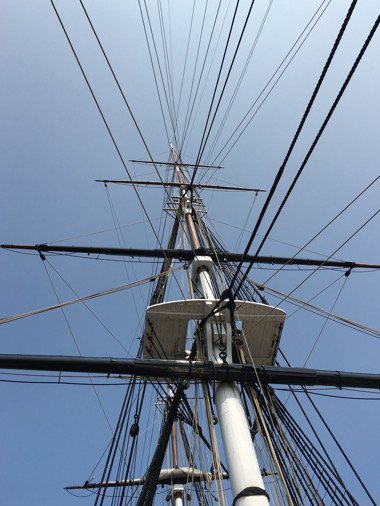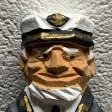-
Posts
1,263 -
Joined
-
Last visited
Content Type
Profiles
Forums
Gallery
Events
Everything posted by Overworked724
-
Yep. It almost cycles through a 90 degree angle from vertical at the stern to mid ships then back to vertical. I used those soft plastic clothes pins a lot as well as the modified binder clips. Made it easier.
- 436 replies
-
- Syren
- Model Shipways
-
(and 1 more)
Tagged with:
-
Yes I did. If it has a ‘curl’ or upward swish at the bow, you will get crowded quickly and the planking becomes quite difficult.
- 436 replies
-
- Syren
- Model Shipways
-
(and 1 more)
Tagged with:
-
I think the 0.025 rope from Syren looks great. Nice job on the long guns!
- 157 replies
-
- model shipways
- syren
-
(and 1 more)
Tagged with:
-
Pg 10 of my build. Great stuff. I used my patented finger tip applicator (finger) on most applications. 🤣
- 436 replies
-
- Syren
- Model Shipways
-
(and 1 more)
Tagged with:
-
I put in the my blog a few pages on. Great stuff.
- 436 replies
-
- Syren
- Model Shipways
-
(and 1 more)
Tagged with:
-
Looks about right!!! My primary weapon was the finger clamp and old episodes of MASH while I waited for the carpenter’s glue to set. 🤣
- 436 replies
-
- Syren
- Model Shipways
-
(and 1 more)
Tagged with:
-
See my build. Had same problem...just went with it. 👍🏽
- 436 replies
-
- Syren
- Model Shipways
-
(and 1 more)
Tagged with:
-
You can apply tung oil after you’ve sanded. But you can add coats later after finishing too. Tung oil is versatile. 😎
- 436 replies
-
- Syren
- Model Shipways
-
(and 1 more)
Tagged with:
-
No...I’m not dead. Just busy. Work hitting me from all sides. Glad to be busy...wish I could afford to retire. The Admiral would love to throw me in the ‘Shipyard Brig’ and feed me under the door like the Count of Monte Christo! 🤣 But she’s happy knowing I’m in the shipyard...where all worldly stress melts away to be replaced by stresses of a different kind.... Where time stops in the shipyard as it proceeds at its normal pace outside the door. My personal little universe of impossible problems followed by brilliant solutions...of horrible failures followed by miraculous recoveries...of stupid ideas born out as ingenious discoveries... ...This royal throne of an armchair nautical historian, this sceptered workbench, this studio of majesty, this seat of Poseidon’s memory, this other Eden, this demi-paradise, this galleon built by History just for me, a bulwark against infection and the hand of worldly concerns, this little heaven, this precious bay set in the silver sea of troubles, and serves as a defensive moat for this beloved house against the envy of less happier people... My blessed plot... My earth... My realm... My...SHIPYARD!!!! (compliments to Shakespeare’s Henry II)
-
Looks like a similar ratio I used. I used Tamiya red and Tamiya desert yellow at about 5:1. You get that nice deeper reddish maroon. Like blood. Looking good!
- 436 replies
-
- Syren
- Model Shipways
-
(and 1 more)
Tagged with:
-
Wally, what wood did you use for the binnacle?
- 950 replies
-
- syren
- model shipways
-
(and 1 more)
Tagged with:
-
I wish I’d added a bit more. You can always sand down extra meat. Something you can’t do if there is a gap. I did have a slight gap at the terminus of the stern planking where the counter begins. It made it more difficult to lock in the planks and also can lead to a misshapen area which needs wood filler and sanding. (Which mine did). I would read other logs and meditate a bit on the planking book, but in the end, I think you’ll make the best decision for your ship. She’s looking very trim! 👍🏽
- 436 replies
-
- Syren
- Model Shipways
-
(and 1 more)
Tagged with:
-
Outstanding! Yep....filing the bell was a nice idea. That piece really shines!
- 950 replies
-
- syren
- model shipways
-
(and 1 more)
Tagged with:
-
Flat screen TV with satellite dish!!! (Kidding) brilliant work!!!!!
- 950 replies
-
- syren
- model shipways
-
(and 1 more)
Tagged with:
-
Toothpicks for the win! I used them on the Sultana in same way. Nice modification!!!! Looks beautiful.
- 157 replies
-
- model shipways
- syren
-
(and 1 more)
Tagged with:
About us
Modelshipworld - Advancing Ship Modeling through Research
SSL Secured
Your security is important for us so this Website is SSL-Secured
NRG Mailing Address
Nautical Research Guild
237 South Lincoln Street
Westmont IL, 60559-1917
Model Ship World ® and the MSW logo are Registered Trademarks, and belong to the Nautical Research Guild (United States Patent and Trademark Office: No. 6,929,264 & No. 6,929,274, registered Dec. 20, 2022)
Helpful Links
About the NRG
If you enjoy building ship models that are historically accurate as well as beautiful, then The Nautical Research Guild (NRG) is just right for you.
The Guild is a non-profit educational organization whose mission is to “Advance Ship Modeling Through Research”. We provide support to our members in their efforts to raise the quality of their model ships.
The Nautical Research Guild has published our world-renowned quarterly magazine, The Nautical Research Journal, since 1955. The pages of the Journal are full of articles by accomplished ship modelers who show you how they create those exquisite details on their models, and by maritime historians who show you the correct details to build. The Journal is available in both print and digital editions. Go to the NRG web site (www.thenrg.org) to download a complimentary digital copy of the Journal. The NRG also publishes plan sets, books and compilations of back issues of the Journal and the former Ships in Scale and Model Ship Builder magazines.





